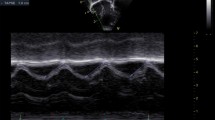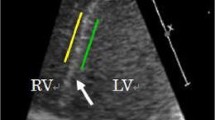Abstract
An established echocardiographic (echo) standard for assessing the newborn right ventricle (RV) for hypertrophy has not been thoroughly developed. This is partially due to the RV’s complex architecture, which makes quantification of RV mass by echo difficult. Here, we retrospectively evaluate the thickness of the inferior RV wall (iRVWT) by echo in neonates and infants with normal cardiopulmonary physiology. Inferior RVWT was defined at the medial portion of the inferior wall of the RV at the mid-ventricular level, collected from a subxiphoid, short axis view. iRVWT was indexed to body surface area (BSA) to the 0.5 power and normalized to iLVWT to explore the best normalization method. Ninety-eight neonates and 32 infants were included in the final analysis. Mean age for neonates and infants was 2 days and 59 days, respectively. Mean ± SD for neonate and infant end-diastole iRVWT was 2.17 ± 0.35 mm and 1.79 ± 0.28 mm, respectively. There was no residual relationship between the index iRVWT and BSA (r = 0.03, p = NS). In the infant cohort, the iRVWT was significantly lower and iLVWT was significantly higher compared to neonate, consistent with known physiologic changes of RV and LV mass. Thus, iRVWT may serve as a reliable and accurate proxy for RV mass and the parameter warrants further evaluation.



Similar content being viewed by others
Data Availability
Deidentified individual participant data, in addition to study protocols, will be made available. The data will be made available on publication to researchers who provide a methodologically sound proposal for use in achieving the goals of the approved proposal. Proposals should be submitted to Dr. James C. Nielsen at james.nielsen@nyulangone.org.
References
Davlouros PA, Niwa K, Webb G, Gatzoulis MA (2006) The right ventricle in congenital heart disease. Heart 92:i27–i38. https://doi.org/10.1136/hrt.2005.077438
Warnes CA (2009) Adult Congenital Heart Disease: importance of the Right Ventricle. J Am Coll Cardiol 54:1903–1910. https://doi.org/10.1016/j.jacc.2009.06.048
Puchalski MD, Williams RV, Askovich B et al (2007) Assessment of right ventricular size and function: echo versus magnetic resonance imaging. Congenit Heart Dis 2:27–31. https://doi.org/10.1111/j.1747-0803.2007.00068.x
Puchalski MD, Lozier JS, Bradley DJ et al (2006) Electrocardiography in the diagnosis of right ventricular hypertrophy in children. Pediatrics 118:1052–1055. https://doi.org/10.1542/peds.2005-2985
Grapsa J, O’Regan DP, Pavlopoulos H et al (2010) Right ventricular remodelling in pulmonary arterial hypertension with three-dimensional echocardiography: comparison with cardiac magnetic resonance imaging. Eur J Echocardiogr 11:64–73. https://doi.org/10.1093/ejechocard/jep169
Lai WW, Gauvreau K, Rivera ES et al (2008) Accuracy of guideline recommendations for two-dimensional quantification of the right ventricle by echocardiography. Int J Cardiovasc Imaging 24:691–698. https://doi.org/10.1007/s10554-008-9314-4
Lopez L, Colan SD, Frommelt PC et al (2010) Recommendations for quantification methods during the performance of a pediatric echocardiogram: a report from the Pediatric Measurements Writing Group of the American Society of Echocardiography Pediatric and Congenital Heart Disease Council. J Am Soc Echocardiogr 23:465–495. https://doi.org/10.1016/j.echo.2010.03.019
Cooper MJ, Teitel DF, Silverman NH, Enderlein M (1984) Comparison of M-mode echocardiographic measurement of right ventricular wall thickness obtained by the subcostal and parasternal approach in children. Am J Cardiol 54:835–838. https://doi.org/10.1016/s0002-9149(84)80216-7
Joyce JJ, Denslow S, Kline CH et al (2001) Estimation of right ventricular free-wall mass using two-dimensional echocardiography. Pediatr Cardiol 22:306–314. https://doi.org/10.1007/s002460010235
Kampmann C, Wiethoff CM, Wenzel A et al (2000) Normal values of M mode echocardiographic measurements of more than 2000 healthy infants and children in central Europe. Heart 83:667–672. https://doi.org/10.1136/heart.83.6.667
Rogé CL, Silverman NH, Hart PA, Ray RM (1978) Cardiac structure growth pattern determined by echocardiography. Circulation 57:285–290. https://doi.org/10.1161/01.CIR.57.2.285
Robert S, Francisco E, Kareem M (1973) Echocardiography in the normal neonate. Circulation 47:108–118. https://doi.org/10.1161/01.CIR.47.1.108
Güzeltaş A, Eroğlu AG (2012) Reference values for echocardiographic measurements of healthy newborns. Cardiol Young 22:152–157. https://doi.org/10.1017/S1047951111001259
Sluysmans T, Colan SD (2005) Theoretical and empirical derivation of cardiovascular allometric relationships in children. J Appl Physiol 99:445–457. https://doi.org/10.1152/japplphysiol.01144.2004
Joyce JJ, Dickson PI, Qi N et al (2004) Normal right and left ventricular mass development during early infancy. Am J Cardiol 93:797–801. https://doi.org/10.1016/j.amjcard.2003.11.063
RStudio Team (2020) RStudio: integrated development for R. RStudio PBC, Boston
Kawel-Boehm N, Maceira A, Valsangiacomo-Buechel ER et al (2015) Normal values for cardiovascular magnetic resonance in adults and children. J Cardiovasc Magn Reson 17:29. https://doi.org/10.1186/s12968-015-0111-7
Geva T (2014) Is MRI the preferred method for evaluating right ventricular size and function in patients with congenital heart disease? Circulation 7:190–197. https://doi.org/10.1161/CIRCIMAGING.113.000553
Blalock SE, Banka P, Geva T et al (2013) Interstudy variability in cardiac magnetic resonance imaging measurements of ventricular volume, mass, and ejection fraction in repaired tetralogy of Fallot: a prospective observational study. J Magn Reson Imaging 38:829–835. https://doi.org/10.1002/jmri.24050
Ntsinjana HN, Hughes ML, Taylor AM (2011) The role of cardiovascular magnetic resonance in pediatric congenital heart disease. J Cardiovasc Magn Reson 13:51. https://doi.org/10.1186/1532-429X-13-51
Schulz-Menger J, Bluemke DA, Bremerich J et al (2020) Standardized image interpretation and post-processing in cardiovascular magnetic resonance—2020 update. J Cardiovasc Magn Reson 22:1–22. https://doi.org/10.1186/s12968-020-00610-6
Yao G-H, Chen X-Y, Zhang Q et al (2019) A novel mathematical model for correcting the physiologic variance of two-dimensional echocardiographic measurements in Healthy Chinese Adults. J Am Soc Echocardiogr 32:876–883.e11. https://doi.org/10.1016/j.echo.2019.02.010
Manning N (2008) The influence of twinning on cardiac development. Early Hum Dev 84:173–179. https://doi.org/10.1016/j.earlhumdev.2008.01.009
Funding
No external funding was provided for this manuscript.
Author information
Authors and Affiliations
Contributions
Dr. JCN and Dr. HDP conceptualized and designed the study. Data collection were performed by Drs. JCN, EH, and HDP. All authors performed data analysis. The first draft of the manuscript was written by Dr. JCN and Dr. HDP and all authors commented on subsequent versions of the manuscript. All authors read and approved the final manuscript.
Corresponding author
Ethics declarations
Conflict of interest
The authors declare that they have no conflict of interest.
Ethical Approval
This research study was conducted retrospectively from data obtained for clinical purposes. We consulted extensively with the NYU School of Medicine Institutional Review Board (IRB) who approved this study. An IRB official waiver of authorization to use identifiable health information for research was granted from the IRB.
Additional information
Publisher's Note
Springer Nature remains neutral with regard to jurisdictional claims in published maps and institutional affiliations.
Rights and permissions
About this article
Cite this article
Pravder, H.D., Hodzic, E., Bhatla, P. et al. Inferior Right Ventricular Wall Thickness by Echocardiogram: A Novel Method of Assessing Hypertrophy in Neonates and Infants. Pediatr Cardiol 41, 1617–1622 (2020). https://doi.org/10.1007/s00246-020-02419-7
Received:
Accepted:
Published:
Issue Date:
DOI: https://doi.org/10.1007/s00246-020-02419-7




